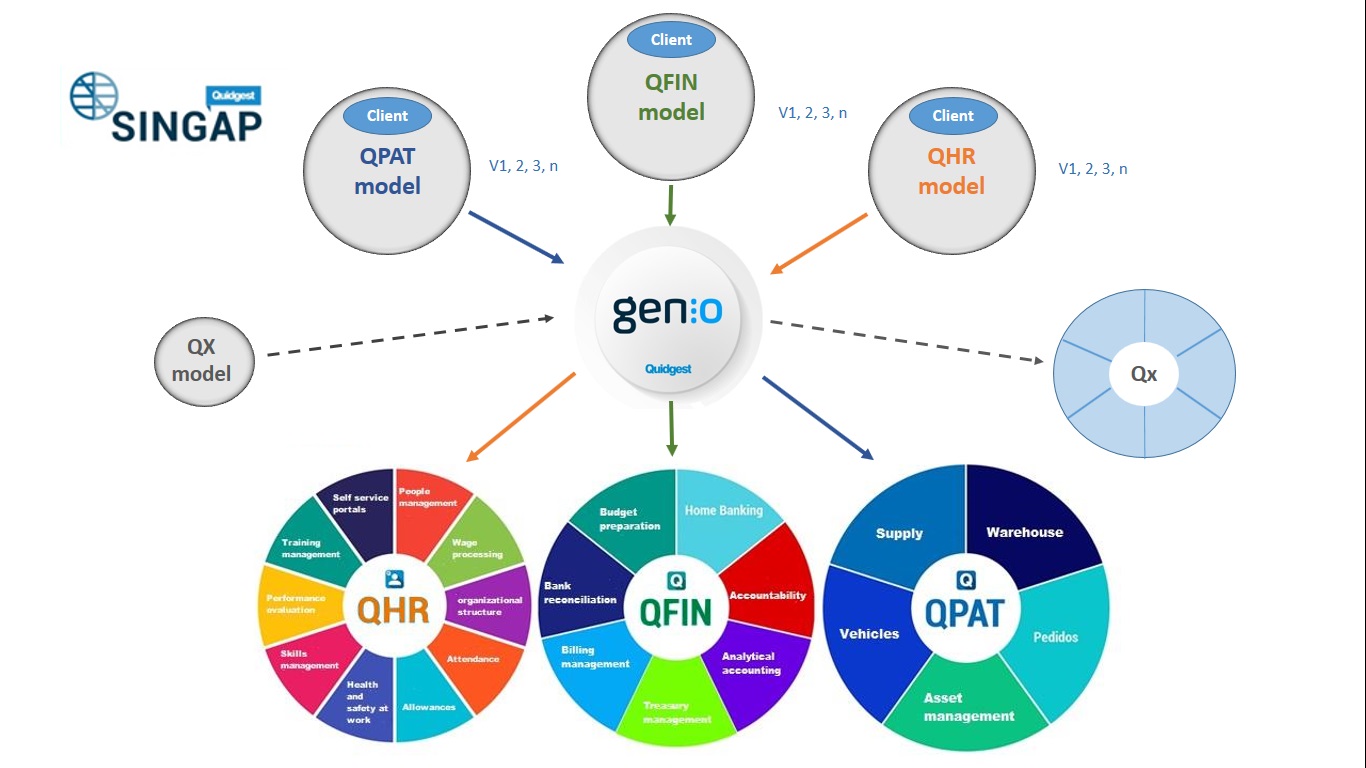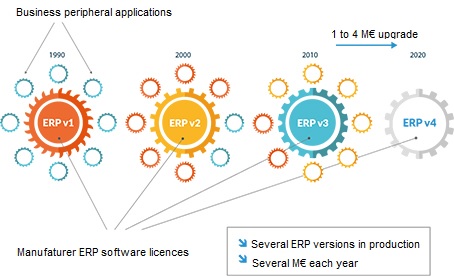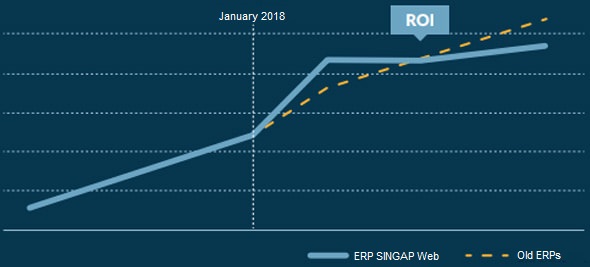
Myth 1. Efficiency and features
The vast majority of ERP packages provide a solution to the most basic business rules. And it feeds a massive network of integrators who add the most specific rules for each business.
Although ERP’s efficiency and basic functionalities work just fine, the existence of multiple applications developed around it by different programmers or, more usually, the vast diversity of Excel sheets that we find, in many clients that have this type of systems, do drastically reduce overall organizational efficiency. Both for daily operations and permanent evolution operations.
Some of these old systems still use codes for data entry rather than menus with options, which gives some efficiency to old users but makes it very difficult for new ones to enter.
Several experts point out that the use of standard ERP is less than 40% due to the (rigid) way in which its providers incorrectly and unsustainably implement it:
ZDNET | CIO | STARTRIBUNE | CIOREVIEW
Another efficiency limitation is licensing per user or megabyte of storage. When another group of users has to enter the system for any operational reason, this change can get stuck in administrative and financial bureaucracies for days, preventing the flow of operations.
Myth 2. Reliability and performance
Nowadays, almost all operating and database systems are robust and reliable, although more flexible and economical. So keeping an old system just for the sake of proven reliability with very high costs and risks doesn’t make sense.
And the famous ERPs stop too! There are cases of critical stops or errors in ERP of large companies. And what they say to users is that it is working how it should, that there is nothing to be done, and everyone waits. There is even the case of a multinational company that stopped the invoicing process in Portugal for several days. When they called the headquarters in the Netherlands, they replied they did not have to worry since the problem was international.
Myth 3. Change and migration high costs and deadlines
One of the main arguments in resistance to change is the total costs indicated for the entire process. And that includes new licenses, installation, training, and migration of pre-existing data to the new system. Below are examples of clients such as the Portuguese Institute of Agricultural and Veterinary Research INIAV, which did the math and concluded that it recovered its investment in the move in about a year.
Another argument that is not valid is the value already invested. As if it were fatal to maintain the old system.
The myth that the more you invest in a system, the more dependent you are on it is fallacious. Competent decision-makers courageously interrupt an extensive investment process when the evidence points to the impossibility of a return within a reasonable period.
In 2018, for example, Lidl canceled a 7-year contract with an ERP supplier to which it had paid 500 million euros.
Seven years earlier, the British National Health System abandoned a £11 billion project.
Myth 4. Security
In 2018, news came out that 90% of the customers of a given ERP were exposed to external attacks due to a 13-year-old flaw.
Of course, all systems have vulnerabilities and can be attacked. The most important aspect is the system’s capacity and speed of replacement and the identification of private and confidential information that has been copied outside the organization.
It is not the aura of famous brand systems that prevents security breaches, but the processes and certifications implemented with ISO 27001 and IAPP, in the case of digital privacy.
Myth 5. Mobility
Many of the ERP’s on the market were launched during the client-server technological era. On Windows or Unix/Linux, and its evolution never happened. A technological shift from ERP to a new generation of responsive mobility involves costs and risks that not everyone is willing to take.
Quidgest is probably the only ERP-producing company that has made this evolution with any speed and ease. Why? Because it uses modeling and automatic code generation and manages, with some ease, to convert a 15-year-old Windows application into another MVC .NET application in a few weeks or a few months.
The other ERPs maintain their structure in antiquated technology and produce satellite applications to give the user the illusion of being in front of the latest technological generation.
Mobility, especially responsive, available on any mobile device or personal computer, is, therefore, a mere marketing buzzword in many ERPs. And this weakness, especially in times of remote working, is very pernicious.
CASE STUDIES
In 2013, a large Portuguese university began a merger process. A dozen of its organic units used the Oracle Financials ERP, where they had invested several million euros, with significant usability and reporting limitations, plus a high risk of downtime.
Quidgest successfully implemented the integrated management solution SINGAP ERP in all ten units in about three months, migrating the data from the old system and subsequently integrating the academic management solution.
This was an essential experience for the ensuing migration process of very large systems.
Public Institute (SAP and Navision migration to Quidgest future-ready ERP)
The Portuguese National Institute of Agricultural and Veterinary Research (INIAV) promotes innovation in the national agricultural sector. With over 600 employees spread over 19 different locations, some with some management autonomy, it centralizes almost all administrative services and management information at its headquarters in Oeiras (Lisbon region).
This body decided to invest in a new ERP in 2016, which would serve as the basis for a broader digital transformation process, with specific training and change management events. The old SAP, Navision, and SRH applications, which respectively managed the financial, invoicing, and human resources areas with high maintenance costs, did not respond to the demands of the new management.
The maintenance costs associated with the inefficiencies resulting from the use of all the old disintegrated applications served as the basis for calculating the tender value. The goal would be to get a return on investment over three years. The public institute achieved in about a year with SINGAP Web Quidgest ERP.
2. University (seven different ERPs migrate to Quidgest future-ready ERP)
Nova University Lisbon, commonly known as NOVA, stands out as a school of world reference. With 11 autonomous organic units, around 20.000 students from 100 nationalities, 1.700 professors, and 40 research units, this is the only Portuguese university with less than five decades of existence that ranks among the 50 best in the world.
At the end of 2016, NOVA decided to acquire an innovative integrated management system, Quidgest’s SINGAP Web ERP, to replace seven different ERPs and thus dynamically respond to its present and future challenges.
A very short deadline was required to start the new solution, as the new aggregating foundation would start operating from May 1st, 2017.
“… In just three months, including one month of training, we had an ERP in operation….” – Ana Rita Marante, NOVA Administrator
Know the details of this project here.
3. Public Institute of Employment and Professional Training (Oracle Financials to Quidgest future-ready ERP migration)
The work carried out with the first university to migrate an old Oracle Financials ERP to SINGAP constituted a valuable experience for Quidgest regarding old data and the structure of tables and relationships in this type of system. Thus, when other organizations launch a competition for its evolution in this domain, as with the IEFP – Institute for Employment and Professional Training, Quidgest has always presented proposals of more excellent value to the client.
The IEFP has an annual budget of more than one billion euros, a figure that gives an idea of the type of customers who choose ERP SINGAP. This is one of his recent projects for the budget, financial, and administrative areas. Another new customer evolving towards management information systems with the most innovative web technologies and complying with the latest procedural and legal requirements, namely the new Accounting Standardization System: SNC-AP.
4. University (Quidgest future-ready ERP migration)
Tired of many years of inefficiencies with very high costs, ISCTE-IUL (a renowned Portuguese public university) dared to launch a tender to update his ERP, and Quidgest made the best proposal. Not only for the competitive price but, above all, for the confidence that it has given to this famous and innovative international management school, both for its technological knowledge of the change process, as well as for the experience of implementing an ERP in other universities.
The hosting of this system will be in the cloud. SINGAP is already prepared for the primary providers of this type of platforms, such as AWS, Azure, and Altice Cloud.
More information here
5. Tourism of Portugal and SME Institute
This is another project similar to the IEFP, with a special feature, as it is about two different entities using the same ERP, adapted to their specificities.
Data migration is also ensured by previous experiences with an ERP that is being discontinued.
Tourism of Portugal already had Quidgest’s human resources management 1ERP module for many years and, therefore, will have an easier task in this implementation than SME Institute (IAPMEI).
6. Other relevant future-ready ERP
Ritz Four Seasons
The Ritz Four Seasons Hotel, headquartered in Lisbon, is managed by Four Seasons, the top company in the world of luxury hotels. Since 2006, it has had a Quidgest human resources management solution, the HR module of Quidgest 1ERP, with successive versions adapted to legislative changes and integrated with the ERP.
With this solution, the Ritz Hotel:
- Increased average productivity levels per employee;
- Linked human resource management with business management;
- Fostered integration and management by processes, increasing competitiveness and creating value for the customer;
- Saved dozens of hours monthly in tasks that started to be performed with the support of the Quidgest system.
Portuguese Parliament
Inserted within the scope of administrative and legislative simplification policies, which aim to contribute to increasing the internal efficiency of public services, the SINGAP system (called SIGAR – Integrated Management System of the Assembly of the Republic), of an evolutionary nature, was implemented in 2009 and integrates , since then, the process of welcoming deputies at the beginning of the legislatures.
The Portuguese Parliament thus integrates the vast portfolio of public sector clients with Quidgest’s SINGAP Web ERP, which includes several organizations such as
IPQ – Portuguese Quality Institute,
LNEC – National Civil Engineering Laboratory,
Regional Coordination and Development Committees of Lisbon, Alentejo and Algarve,
ICNF – Institute for the Conservation of Nature and Forests,
among many others.
CONCLUSIONS
More and more organizations, mainly medium and large ones, are evolving their management systems towards solutions, more adjusted to the changing demands of the new times.
To this end, they are abandoning or considering abandoning the old rigid ERP acquired in recent decades. They have invested astronomical amounts and are dragging on with high and risky costs in terms of maintenance and evolution.
A new architecture of Composable Enterprise and PBC solutions – Packaged Business Capabilities for more agile and resilient companies and institutions, is accelerating the process of migration to ERP of a new era, also more agile and flexible. Quidgest, with its future-ready ERP, has led this path of innovation for more than three decades, with a solution that is already based on these concepts and many other differentiating features.
The greater the number of customers and partners that join this wave of migration, the safer the process becomes, the lower the costs are, and the greater the competitiveness and agility of everyone involved.
We are in a time of accelerated changes. And success lurks the most agile. With new technologies and features incorporated on information systems, whenever the business or activity so requires.
Carlos Costa – Marketing & Partnership Development Manager
ABOUT
Quidgest is a global technology company headquartered in Lisbon and a pioneer in intelligent software modeling and generation. Through its unique generative AI platform, Genio, develops complex, urgent, and specific systems, ready to evolve continuously, flexible, and scalable for various technologies and platforms. Partners and large organizations such as governments, multinational companies, and global multilateral institutions use Quidgest’s solutions to achieve their digital strategies.
FUTURE-READY SOFTWARE
CONTACTS
R. Viriato, 7
1050-233 Lisboa | Portugal
Tel. +351 213 870 563
quidgest@quidgest.com





